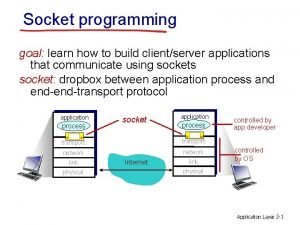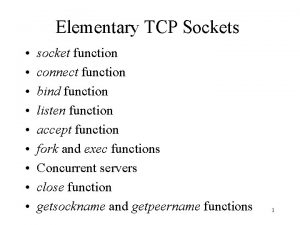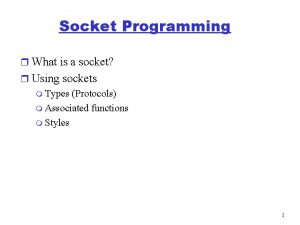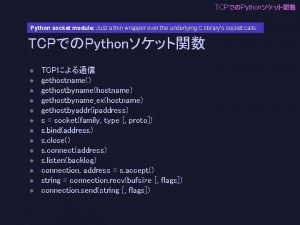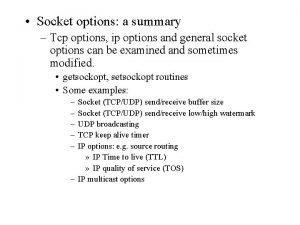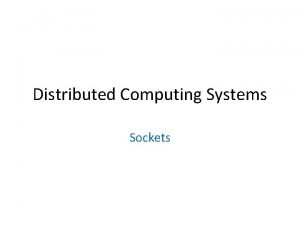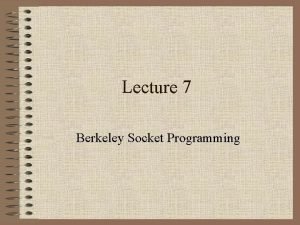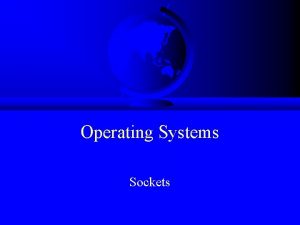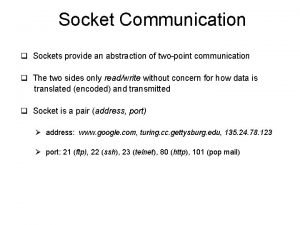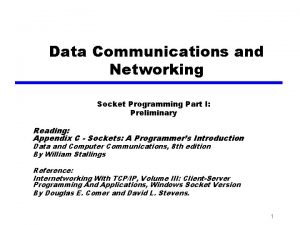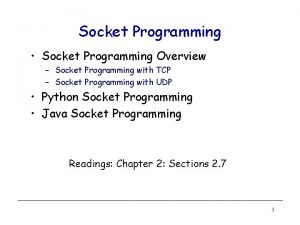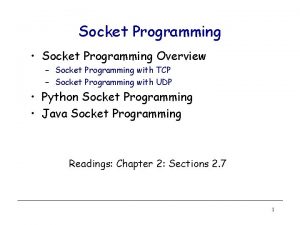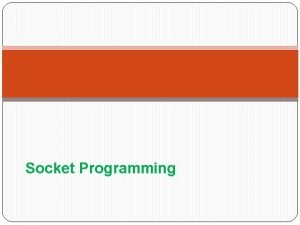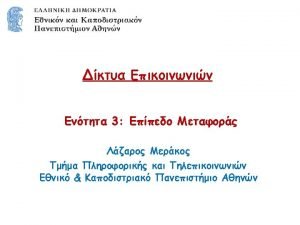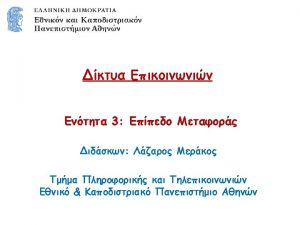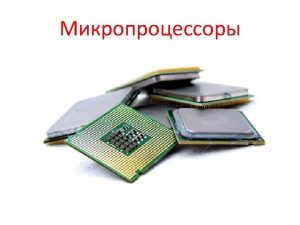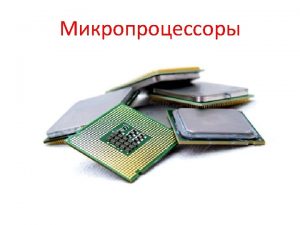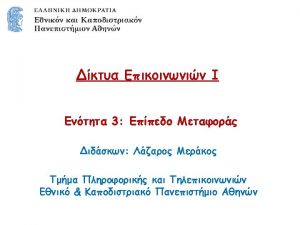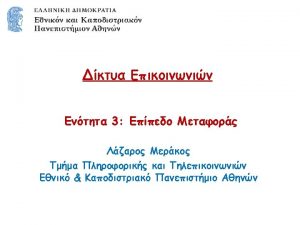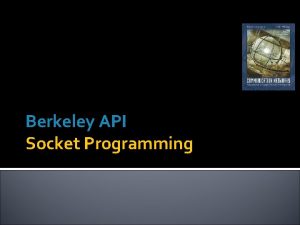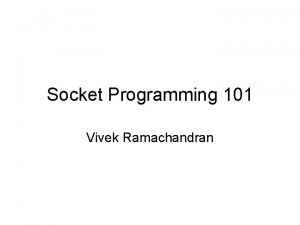Socket Programming r What is a socket r
















![The struct sockaddr r The generic: struct sockaddr { u_short sa_family; char sa_data[14]; }; The struct sockaddr r The generic: struct sockaddr { u_short sa_family; char sa_data[14]; };](https://slidetodoc.com/presentation_image_h/c63cd0585a0d09c38a9487df7ac6d25d/image-17.jpg)










- Slides: 27

Socket Programming r What is a socket? r Using sockets m Types (Protocols) m Associated functions m Styles m We will look at using sockets in C m For Java, see Chapter 2. 6 -2. 8 (optional) • Note: Java sockets are conceptually quite similar 1

What is a socket? r An interface between application and network m The application creates a socket m The socket type dictates the style of communication • reliable vs. best effort • connection-oriented vs. connectionless r Once configured the application can m pass data to the socket for network transmission m receive data from the socket (transmitted through the network by some other host) 2

Two essential types of sockets r SOCK_STREAM m m m r SOCK_DGRAM a. k. a. TCP reliable delivery in-order guaranteed connection-oriented bidirectional m m m App 3 2 1 socket Dest. a. k. a. UDP unreliable delivery no order guarantees no notion of “connection” – app indicates dest. for each packet can send or receive D 1 App 3 2 1 D 2 socket Q: why have type SOCK_DGRAM? D 3 3

Socket Creation in C: socket r int s = socket(domain, type, protocol); m s: socket descriptor, an integer (like a file-handle) m domain: integer, communication domain • e. g. , PF_INET (IPv 4 protocol) – typically used m type: communication type • SOCK_STREAM: reliable, 2 -way, connection-based service • SOCK_DGRAM: unreliable, connectionless, • other values: need root permission, rarely used, or obsolete specifies protocol (see file /etc/protocols for a list of options) - usually set to 0 r NOTE: socket call does not specify where data will be coming from, nor where it will be going to – it just creates the interface! 4 m protocol:

A Socket-eye view of the Internet medellin. cs. columbia. edu (128. 59. 21. 14) newworld. cs. umass. edu (128. 119. 245. 93) cluster. cs. columbia. edu (128. 59. 21. 14, 128. 59. 16. 7, 128. 59. 16. 5, 128. 59. 16. 4) r Each host machine has an IP address r When a packet arrives at a host 5

Ports r Each host has 65, 536 ports r Some ports are reserved for specific apps Port 0 Port 1 Port 65535 m 20, 21: FTP r A socket provides an interface m 23: Telnet to send data to/from the network through a port m 80: HTTP m see RFC 1700 (about 2000 ports are reserved) 6

Addresses, Ports and Sockets r Like apartments and mailboxes m You are the application m Your apartment building address is the address m Your mailbox is the port m The post-office is the network m The socket is the key that gives you access to the right mailbox (one difference: assume outgoing mail is placed by you in your mailbox) r Q: How do you choose which port a socket connects to? 7

The bind function r associates and (can exclusively) reserves a port for use by the socket r int status = bind(sockid, &addrport, size); m m status: error status, = -1 if bind failed sockid: integer, socket descriptor addrport: struct sockaddr, the (IP) address and port of the machine (address usually set to INADDR_ANY – chooses a local address) size: the size (in bytes) of the addrport structure r bind can be skipped for both types of sockets. When and why? 8

Skipping the bind r SOCK_DGRAM: m if only sending, no need to bind. The OS finds a port each time the socket sends a pkt m if receiving, need to bind r SOCK_STREAM: m destination determined during conn. setup m don’t need to know port sending from (during connection setup, receiving end is informed of port) 9

Connection Setup (SOCK_STREAM) r Recall: no connection setup for SOCK_DGRAM r A connection occurs between two kinds of participants m m passive: waits for an active participant to request connection active: initiates connection request to passive side r Once connection is established, passive and active participants are “similar” m m both can send & receive data either can terminate the connection 10

Connection setup cont’d r Passive participant m step 1: listen (for incoming requests) m step 3: accept (a request) m step 4: data transfer r The accepted connection is on a new socket r The old socket continues to listen for other active participants r Why? r Active participant m m step 2: request & establish connection step 4: data transfer Passive Participant a-sock-1 l-sock a-sock-2 socket Active 1 Active 2 11

Connection setup: listen & accept r Called by passive participant r int status = listen(sock, queuelen); m status: 0 if listening, -1 if error m sock: integer, socket descriptor m queuelen: integer, # of active participants that can “wait” for a connection m listen is non-blocking: returns immediately r int s = accept(sock, &namelen); m s: integer, the new socket (used for data-transfer) m sock: integer, the orig. socket (being listened on) m name: struct sockaddr, address of the active participant m namelen: sizeof(name): value/result parameter • must be set appropriately before call • adjusted by OS upon return m accept is blocking: waits for connection before returning 12

connect call r int status = connect(sock, &name, namelen); m status: 0 if successful connect, -1 otherwise m sock: integer, socket to be used in connection m name: struct sockaddr: address of passive participant m namelen: integer, sizeof(name) r connect is blocking 13

Sending / Receiving Data r With a connection (SOCK_STREAM): m int count = send(sock, &buf, len, flags); • • m int • • count: # bytes transmitted (-1 if error) buf: char[], buffer to be transmitted len: integer, length of buffer (in bytes) to transmit flags: integer, special options, usually just 0 count = recv(sock, &buf, len, flags); count: # bytes received (-1 if error) buf: void[], stores received bytes len: # bytes received flags: integer, special options, usually just 0 m Calls are blocking [returns only after data is sent (to socket buf) / received] 14

Sending / Receiving Data (cont’d) r Without a connection (SOCK_DGRAM): m int count = sendto(sock, &buf, len, flags, &addr, addrlen); • count, sock, buf, len, flags: same as send • addr: struct sockaddr, address of the destination • addrlen: sizeof(addr) m int count = recvfrom(sock, &buf, len, flags, &addrlen); • count, sock, buf, len, flags: same as recv • name: struct sockaddr, address of the source • namelen: sizeof(name): value/result parameter r Calls are blocking [returns only after data is sent (to socket buf) / received] 15

close r When finished using a socket, the socket should be closed: r status = close(s); 0 if successful, -1 if error m s: the file descriptor (socket being closed) m status: r Closing a socket m closes a connection (for SOCK_STREAM) m frees up the port used by the socket 16
![The struct sockaddr r The generic struct sockaddr ushort safamily char sadata14 The struct sockaddr r The generic: struct sockaddr { u_short sa_family; char sa_data[14]; };](https://slidetodoc.com/presentation_image_h/c63cd0585a0d09c38a9487df7ac6d25d/image-17.jpg)
The struct sockaddr r The generic: struct sockaddr { u_short sa_family; char sa_data[14]; }; m sa_family • specifies which address family is being used • determines how the remaining 14 bytes are used r The Internet-specific: struct sockaddr_in { short sin_family; u_short sin_port; struct in_addr sin_addr; char sin_zero[8]; }; m sin_family = AF_INET m sin_port: port # (0 -65535) m sin_addr: IP-address m sin_zero: unused 17

Address and port byte-ordering r Address and port are stored as integers m m u_short sin_port; (16 bit) in_addr sin_addr; (32 bit) struct in_addr { u_long s_addr; }; r Problem: m different machines / OS’s use different word orderings • little-endian: lower bytes first • big-endian: higher bytes first m these machines may communicate with one another over the network 128. 119. 40. 12 128 Big-Endian machine 119 40 12 Little-Endian machine N O R 119 40 W 128 ! ! ! G 12. 40. 119. 128 12 18

Solution: Network Byte-Ordering r Defs: m Host Byte-Ordering: the byte ordering used by a host (big or little) m Network Byte-Ordering: the byte ordering used by the network – always big-endian r Any words sent through the network should be converted to Network Byte-Order prior to transmission (and back to Host Byte-Order once received) r Q: should the socket perform the conversion automatically? r Q: Given big-endian machines don’t need conversion routines and little-endian machines do, how do we avoid writing two versions of code? 19

UNIX’s byte-ordering funcs r u_long htonl(u_long x); r u_long ntohl(u_long x); r u_short htons(u_short x); r u_short ntohs(u_short x); r On big-endian machines, these routines do nothing r On little-endian machines, they reverse the byte order hto 128 119 40 12 Little-Endian 12 machine 128 119 40 40 119 128. 119. 40. 12 12 ntohl nl 128 119 40 128. 119. 40. 12 Big-Endian 12 machine r Same code would have worked regardless of endian- ness of the two machines 20

Dealing with blocking calls r Many of the functions we saw block until a certain event m m accept: until a connection comes in connect: until the connection is established recv, recvfrom: until a packet (of data) is received send, sendto: until data is pushed into socket’s buffer • Q: why not until received? r For simple programs, blocking is convenient r What about more complex programs? m multiple connections m simultaneous sends and receives m simultaneously doing non-networking processing 21

Dealing w/ blocking (cont’d) r Options: m create multi-process or multi-threaded code m turn off the blocking feature (e. g. , using the fcntl filedescriptor control function) m use the select function call. r What does select do? m can be permanent blocking, time-limited blocking or nonblocking m input: a set of file-descriptors m output: info on the file-descriptors’ status m i. e. , can identify sockets that are “ready for use”: calls involving that socket will return immediately 22

select function call r int status = select(nfds, &readfds, &writefds, &exceptfds, &timeout); # of ready objects, -1 if error m nfds: 1 + largest file descriptor to check m readfds: list of descriptors to check if read-ready m writefds: list of descriptors to check if write-ready m exceptfds: list of descriptors to check if an exception is registered m status: time after which select returns, even if nothing ready - can be 0 or (point timeout parameter to NULL for ) m timeout: 23

To be used with select: r Recall select uses a structure, struct fd_set m it is just a bit-vector m if bit i is set in [readfds, writefds, exceptfds], select will check if file descriptor (i. e. socket) i is ready for [reading, writing, exception] r Before calling select: m FD_ZERO(&fdvar): clears the structure m FD_SET(i, &fdvar): to check file desc. i r After calling select: m int FD_ISSET(i, &fdvar): boolean returns TRUE iff i is “ready” 24

Other useful functions r bzero(char* c, int n): 0’s n bytes starting at c r gethostname(char *name, int len): gets the name of the current host r gethostbyaddr(char *addr, int len, int type): converts IP hostname to structure containing long integer r inet_addr(const char *cp): converts dotted-decimal char-string to long integer r inet_ntoa(const struct in_addr in): converts long to dotted-decimal notation r Warning: check function assumptions about byte- ordering (host or network). Often, they assume parameters / return solutions in network byteorder 25

Release of ports r Sometimes, a “rough” exit from a program (e. g. , ctrl -c) does not properly free up a port r Eventually (after a few minutes), the port will be freed r To reduce the likelihood of this problem, include the following code: #include <signal. h> void clean. Exit(){exit(0); } m in socket code: signal(SIGTERM, clean. Exit); signal(SIGINT, clean. Exit); 26

Final Thoughts r Make sure to #include the header files that define used functions r Check man-pages and course web-site for additional info 27
 Socket connection
Socket connection Bsd socket interface
Bsd socket interface Bind function in socket programming
Bind function in socket programming R socket programming
R socket programming Programming
Programming Udp broadcast c
Udp broadcast c Tcp and udp socket programming in java
Tcp and udp socket programming in java R socket programming
R socket programming Greedy vs dynamic
Greedy vs dynamic Runtime programming
Runtime programming Integer programming vs linear programming
Integer programming vs linear programming Perbedaan linear programming dan integer programming
Perbedaan linear programming dan integer programming Programing adalah
Programing adalah Gethostbyaddr python
Gethostbyaddr python Tcp socket options
Tcp socket options Socket in distributed system
Socket in distributed system Raw socket quotes
Raw socket quotes Berkeley socket is used for
Berkeley socket is used for Sock_addr_in
Sock_addr_in Ball and socket joint
Ball and socket joint Wetoverload
Wetoverload Bind listen accept recv
Bind listen accept recv Secure socket layer and transport layer security
Secure socket layer and transport layer security Ball and socket joint
Ball and socket joint Socket abstraction
Socket abstraction Recv winsock
Recv winsock Callbacks
Callbacks Iocp 서버
Iocp 서버
